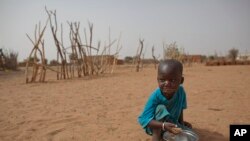There’s new evidence linking hot desert sandstorms in Africa to bacterial meningitis in the Sahel, an area that stretches from Senegal in the west to Ethiopia in the east. Known as the “meningitis belt,” researchers have homed in on why the region has its name.
Sandstorms are a fact of life in West Africa's Sahel region.
New research suggests that exposure to all that airborne dust, along with the already high temperatures contribute to the high number of bacterial meningitis cases each year.”
Most people carry the bacteria that causes meningitis in their nasal passages, but British and Belgian researchers think that sand and other airborne debris people breathe in during a sandstorm carries the bacteria high into the respiratory tract where it is more likely to develop into the deadly infection.
Daniel Neill is a researcher at the University of Liverpool in the school’s Institute of Infection and Global Health.
“In our noses, mouths and throats some of these bacteria live quite harmlessly, and that’s very common throughout the world ,” said Neill. "But what’s very rare is for these bacteria to move from these sites in the nose and mouth and throat to places like the brain, lungs or bloodstream where they cause severe disease. So what we were able to show was that the dust causes the likelihood of the bacteria moving from the mouth, nose or throat from these other sites where they cause severe infection.”
Over the past ten years, there have been about one million cases of bacterial meningitis in the Sahel, resulting in some 100,000 deaths.
Streptococcus pneumoniae can cause often-lethal inflammation of the lining of the brain. Neill says it is treated aggressively with antibiotics, and effective meningitis vaccines have significantly reduced the incidence of the disease.
For their study, published in the Journal of Allergy and Clinical Immunology, Neill and colleagues spent eight years studying dust storms in the Sahel – which encompasses 26 countries with a population of 300 million people. Their work focused on Niger.
Investigators measured periods of visibility during the storms. They found that the lower the visibility - where people could see for no more than three meters - the more cases there were of meningitis.
When combined with extremely hot temperatures, he suggests, the bacteria release toxins that make it hard for the immune system to fight off infection.
Neill says the number of meningitis cases might be reduced if people who must go outdoors during a sand storm cover their noses and mouths with scarves or gauze material.
“And that’s something that we could test relatively simply in which we’d like to do in the future is just to see whether adopting simple measures like that can affect the incidences of meningitis in these parts of the world,” said Neill.
Dust storms tend to occur during the Sahel’s dry season, the hottest part of the year. Neill says by monitoring climate conditions, it may be possible to forecast when the most dangerous storms are likely to occur.
